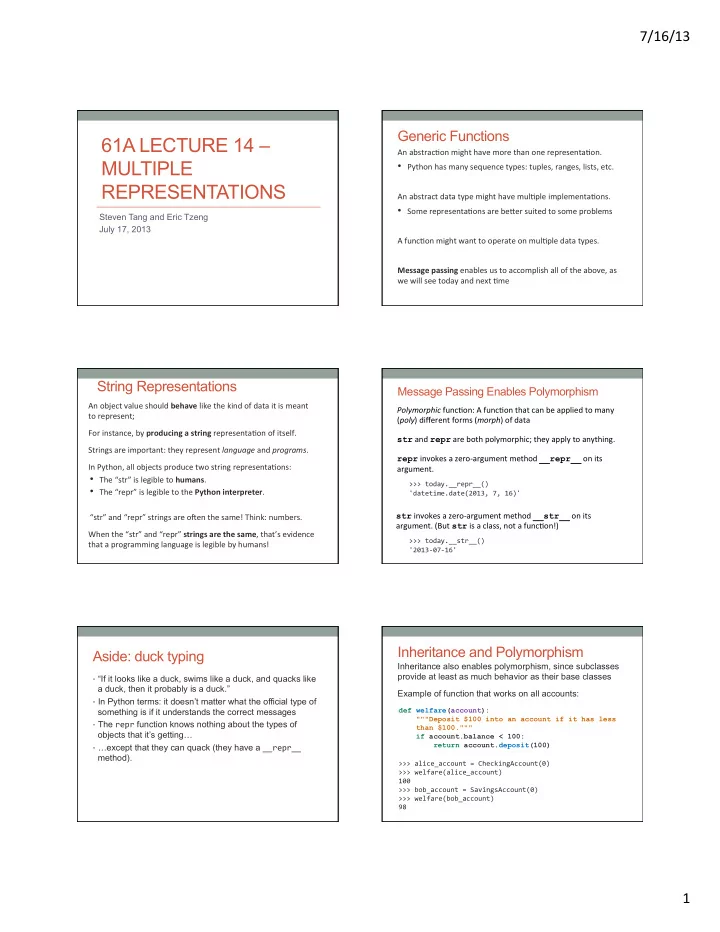

7/16/13 ¡ Generic Functions 61A LECTURE 14 – An ¡abstrac/on ¡might ¡have ¡more ¡than ¡one ¡representa/on. ¡ MULTIPLE • Python ¡has ¡many ¡sequence ¡types: ¡tuples, ¡ranges, ¡lists, ¡etc. ¡ ¡ REPRESENTATIONS An ¡abstract ¡data ¡type ¡might ¡have ¡mul/ple ¡implementa/ons. ¡ • Some ¡representa/ons ¡are ¡beBer ¡suited ¡to ¡some ¡problems ¡ Steven Tang and Eric Tzeng ¡ July 17, 2013 A ¡func/on ¡might ¡want ¡to ¡operate ¡on ¡mul/ple ¡data ¡types. ¡ ¡ Message ¡passing ¡enables ¡us ¡to ¡accomplish ¡all ¡of ¡the ¡above, ¡as ¡ we ¡will ¡see ¡today ¡and ¡next ¡/me ¡ String Representations Message Passing Enables Polymorphism An ¡object ¡value ¡should ¡ behave ¡like ¡the ¡kind ¡of ¡data ¡it ¡is ¡meant ¡ Polymorphic ¡func/on: ¡A ¡func/on ¡that ¡can ¡be ¡applied ¡to ¡many ¡ to ¡represent; ¡ ( poly ) ¡different ¡forms ¡( morph ) ¡of ¡data ¡ For ¡instance, ¡by ¡ producing ¡a ¡string ¡ representa/on ¡of ¡itself. ¡ str ¡and ¡ repr ¡are ¡both ¡polymorphic; ¡they ¡apply ¡to ¡anything. ¡ Strings ¡are ¡important: ¡they ¡represent ¡ language ¡and ¡ programs . ¡ repr ¡invokes ¡a ¡zero-‑argument ¡method ¡ __repr__ ¡on ¡its ¡ In ¡Python, ¡all ¡objects ¡produce ¡two ¡string ¡representa/ons: ¡ argument. ¡ • The ¡“str” ¡is ¡legible ¡to ¡ humans . ¡ >>> ¡today.__repr__() ¡ • The ¡“repr” ¡is ¡legible ¡to ¡the ¡ Python ¡interpreter . ¡ 'datetime.date(2013, ¡7, ¡16)' ¡ “str” ¡and ¡“repr” ¡strings ¡are ¡oNen ¡the ¡same! ¡Think: ¡numbers. ¡ str ¡invokes ¡a ¡zero-‑argument ¡method ¡ __str__ ¡on ¡its ¡ argument. ¡(But ¡ str ¡is ¡a ¡class, ¡not ¡a ¡func/on!) ¡ When ¡the ¡“str” ¡and ¡“repr” ¡ strings ¡are ¡the ¡same , ¡that’s ¡evidence ¡ >>> ¡today.__str__() ¡ that ¡a ¡programming ¡language ¡is ¡legible ¡by ¡humans! ¡ '2013-‑07-‑16' ¡ Inheritance and Polymorphism Aside: duck typing Inheritance also enables polymorphism, since subclasses provide at least as much behavior as their base classes • “If it looks like a duck, swims like a duck, and quacks like a duck, then it probably is a duck.” Example of function that works on all accounts: • In Python terms: it doesn’t matter what the official type of def welfare(account): something is if it understands the correct messages """Deposit $100 into an account if it has less • The repr function knows nothing about the types of than $100.""" objects that it’s getting… if account.balance < 100: return account.deposit(100) • …except that they can quack (they have a __repr__ method). >>> ¡alice_account ¡= ¡CheckingAccount(0) ¡ >>> ¡welfare(alice_account) ¡ 100 ¡ >>> ¡bob_account ¡= ¡SavingsAccount(0) ¡ >>> ¡welfare(bob_account) ¡ 98 ¡ 1 ¡
7/16/13 ¡ Interfaces Special Methods Message ¡passing ¡allows ¡ different ¡data ¡types ¡to ¡respond ¡to ¡the ¡ same ¡message . ¡ Python operators and generic functions make use of methods with names like “ __name__ ” A ¡shared ¡message ¡that ¡elicits ¡similar ¡behavior ¡from ¡different ¡ These are special or magic methods object ¡classes ¡is ¡a ¡powerful ¡method ¡of ¡abstrac/on. ¡ Examples: An ¡ interface ¡is ¡a ¡ set ¡of ¡shared ¡messages , ¡along ¡with ¡a ¡ specifica/on ¡of ¡ what ¡they ¡mean . ¡ len __len__ +, += __add__, __iadd__ Classes ¡that ¡implement ¡ __repr__ ¡and ¡ __str__ ¡methods ¡ that ¡return ¡Python-‑ ¡and ¡human-‑readable ¡strings ¡thereby ¡ [], []= __getitem__, __setitem__ implement ¡an ¡interface ¡for ¡producing ¡Python ¡string ¡ . __getattr__, representa/ons. ¡ __setattr__ Classes ¡that ¡implement ¡ __len__ ¡and ¡ __getitem__ ¡are ¡ sequences. ¡ ¡ Example: Rational Numbers Property Methods ONen, ¡we ¡want ¡the ¡value ¡of ¡instance ¡aBributes ¡to ¡be ¡linked. ¡ class Rational(object): def __init__(self, numer, denom): g = gcd(numer, denom) >>> ¡f ¡= ¡Rational(3, ¡5) ¡ self.numerator = numer // g >>> ¡f.float_value ¡ self.denominator = denom // g 0.6 ¡ @property def __repr__(self): >>> ¡f.numerator ¡= ¡4 ¡ return 'Rational({0}, {1})'.format(self.numerator, def float_value(self): >>> ¡f.float_value ¡ self.denominator) return (self.numerator // 0.8 ¡ def __str__(self): self.denominator) >>> ¡f.denominator ¡-‑= ¡3 ¡ return '{0}/{1}'.format(self.numerator, >>> ¡f.float_value ¡ self.denominator) def __add__(self, num): 2.0 ¡ denom = self.denominator * num.denominator The ¡ @property ¡decorator ¡on ¡a ¡method ¡designates ¡that ¡it ¡will ¡ numer1 = self.numerator * num.denominator numer2 = self.denominator * num.numerator be ¡called ¡whenever ¡it ¡is ¡ looked ¡up ¡on ¡an ¡instance. ¡ ¡ return Rational(numer1 + numer2, denom) def __eq__(self, num): It ¡allows ¡zero-‑argument ¡methods ¡to ¡be ¡called ¡without ¡an ¡explicit ¡ return (self.numerator == num.numerator and call ¡expression. ¡ self.denominator == num.denominator) Multiple Representations of Abstract Data Arithmetic Abstraction Barriers Rectangular ¡and ¡polar ¡representa/ons ¡for ¡complex ¡numbers ¡ Complex ¡numbers ¡as ¡whole ¡data ¡values ¡ add_complex ¡ ¡mul_complex ¡ Complex ¡numbers ¡as ¡two-‑dimensional ¡vectors ¡ real ¡ ¡imag ¡ ¡magnitude ¡ ¡angle ¡ Rectangular ¡ Polar ¡ representa=on ¡ representa=on ¡ Most ¡opera/ons ¡don't ¡care ¡about ¡the ¡representa/on. ¡ Some ¡mathema/cal ¡opera/ons ¡are ¡easier ¡on ¡one ¡than ¡the ¡other. ¡ 2 ¡
Recommend
More recommend